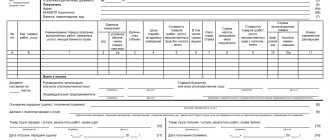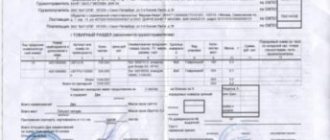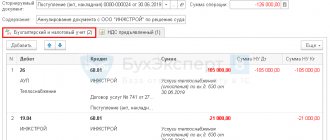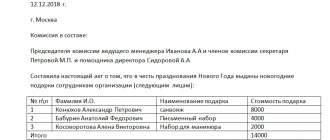What is it, what documents can it be used instead of?
UPD is active and is used in the document flow of various organizations. It was introduced and legalized by the Federal Tax Service (FTS) by letter dated October 21, 2013 No. ММВ-20-3/96.
Differences between UTD and invoices:
- The difference between the UPD and the consignment note (TORG-12) is that the UPD contains, in addition to the listing of the goods, the price for each product, the total amount, and also data on VAT, customs declaration and the country of origin of the goods.
- It differs from the commodity transport document by the absence of a transport component of the document.
Signatures on invoices and UPD
The invoice and UPD are signed by the head and chief accountant of the organization or other persons authorized to do so by an order (other administrative document) for the organization or a power of attorney on behalf of the organization (Clause 6 of Article 169 of the Tax Code of the Russian Federation, Appendix No. 3 to the Letter of the Federal Tax Service of Russia dated 21.10 .2013 No. ММВ-203/ [email protected] ).
Among the most common errors associated with signing documents are the following: the use of a facsimile signature, the invoice and UPD were signed by one person, but the transcript of the signature indicates another, the documents were signed by an unauthorized person.
Letters of the Ministry of Finance of Russia dated April 10, 2013 No. 0307-09/11863, dated April 23, 2012 No. 03-07-09/39 contain the following explanations: the norms of the Tax Code of the Russian Federation indicate in invoices additional details (information), including the position of the authorized person , who signed the relevant invoice, is not prohibited.
If the invoice issued to the buyer is signed by some authorized persons, and the copy of the invoice remaining with the seller by others, then this is not a violation of the procedure for issuing invoices (Letters of the Federal Tax Service of Russia dated July 3, 2013 No. 0307-15/25437, dated July 19, 2013 No. ED-4-3/13161).
It should be noted that applying a deduction based on an invoice and UPD certified by a facsimile signature is illegal. This position is shared by regulatory authorities and courts (Letters of the Ministry of Finance of Russia dated December 8, 2017 No. 0303-06/1/81951, dated August 27, 2015 No. 03-07-09/49478, dated June 1, 2010 No. 03-07-09/33, dated 17.09.2009 No. 03-0709/48, dated 17.06.2009 No. 0307-09/31, dated 28.04.2009 No. 03-07-09/24, dated 22.01.2009 No. 03-07-11/17, Federal Tax Service of the Russian Federation dated February 14, 2005 No. 03-1-03/210/11, Ruling of the Supreme Court of the Russian Federation dated January 22, 2016 No. 307KG15-18124, Resolution of the Presidium of the Supreme Arbitration Court of the Russian Federation dated September 27, 2011 No. 4134/11, etc.)
In conclusion, we note that an ordinary desk tax audit, when “docking” indicators from the declarations of the taxpayer and his counterparties, is unlikely to identify the errors described above.
Nevertheless, you should not neglect the rules for preparing invoices and UPD, since no one is immune from in-depth desk and on-site tax audits.
| Egorova Olga Viktorovna, Tax Expert (Moscow) |
Back
Forward
When is it issued?
To simplify document flow, a single form of a universal transfer document has been developed. UPD can be used by both organizations and individual entrepreneurs. Its application is possible under any taxation system.
- supply of goods, services or performance of work;
- transfer of property rights of use.
Benefits of use:
- reduction of document flow;
- a unified style and form of registration of various accounting documents such as TORG-12, M-15, transfer acts, TTN;
- reduction of time for registration, processing, verification of all types of documents when there is a single form;
- a single document reduces the risk of discrepancies in numbers and details between documents for one economic transaction;
- reducing costs for paper and archival storage space.
Does it replace an invoice, a waybill TORG-12 and a transport note (TTN)?
Let's consider whether the universal transfer act replaces the consignment note (TTN) or not, which is better - UPD or TORG-12, and whether a consignment note is needed if there is a universal document.
The UPD does not replace the waybill, since it does not contain lines related to transport that are available in the second document. A bill of lading is needed to accompany the transportation of goods .
A consignment note in form N 1-T is issued in any case, regardless of who delivers the goods : the buyer, the seller or a hired carrier hired by any of the parties to the contract.
Articles on the topic (click to view)
- Do you know what a trademark is and what its meaning is? Definition of concept and types, characteristics and examples
- What to do if your credit history is damaged: how to “rehabilitate” the borrower
- Classification of industrial goods
- What financial guarantee is required for a visa to Italy?
- Fedresurs bankruptcy of individuals
- How does a simplified bankruptcy procedure for a legal entity occur: procedure
- The procedure for dismissing employees in the event of bankruptcy of an enterprise, required compensation and payments
UPD can replace an invoice, since the main part is formed in its image and likeness and contains all the necessary data.
Expert opinion
Makarov Igor Tarasovich
Legal consultant with 8 years of experience. Specialization: criminal law. Extensive experience in document examination.
In addition to the mandatory invoice details listed in paragraph 5 and paragraph 6 of Article 169 of the Tax Code of the Russian Federation, the UPD contains the mandatory data of the primary accounting document, legalized by parts 2 of Article 9 of Law No. 402-FZ.
TN
The waybill is a mandatory document according to the Post. Government No. 272 dated April 15, 2011. Typically, the TN is filled out by the sender of the cargo, unless another procedure is specified in the transportation contract. The document is drawn up for one batch or for several batches of goods and materials if they are transported by one truck.
Three original copies of the TN are filled out:
- to the sender;
- recipient;
- to the carrier.
The difference with the previous form, TTN, is the absence of a product section as such. This is reflected in the title of the document. The write-off and registration of transported goods and materials on the basis of technical specifications are not carried out.
You should keep in mind the Post. Government No. 1529 dated 12/12/17, according to which the legal emphasis of the rules for the transportation of goods by road has changed. Now the rules regulate the transportation of heavy (large) vehicles. Previously, the rules regulated the transportation, respectively, of heavy (oversized) cargo.
The changes also affected the technical document, as a document recording business transactions in this area:
- Section 13 is devoted to the route of transport, including those transporting hazardous goods and materials;
- Section 15 contains the amount of services of the ATP carrier, the amount of payment for the transportation of the relevant goods.
In Section 13, when transporting dangerous goods by car, the details of the transportation permit are also indicated.
Thus, the indicators of the two invoices are as close as possible in meaning and content.
Which document should be drawn up when transferring property: a transfer and acceptance certificate or an invoice in form N TORG-12 ?
How is a universal transfer document drawn up?
The UPD was developed on the basis of an invoice, therefore it includes the following data:
- serial number and actual date of compilation;
- information about the seller and buyer (name of organization, legal address, tax identification number/registration number);
- name and address of the shipper and consignee;
- identifier of the government contract, the agreement on the basis of which the transaction was carried out;
- surname and initials (first name, patronymic), positions and signatures of those who completed the business transaction (sale of goods/services) and those responsible for its execution;
- line “to the payment document” (filled in if an advance was received);
- name of the product/service;
- unit of measurement of goods/services (kg, liter, etc.);
- quantity of goods/services;
- cost per unit of product/service;
- currency in which settlements are made;
- excise tax data, if it is an excise product;
- tax rate;
- the total amount of tax due;
- the total cost of all goods/services supplied;
- country of origin of the goods, if this is the subject of the transaction;
- customs declaration number (if the product is of foreign origin).
UPD contains all the necessary information:
- title “Universal transfer document”;
- real compilation time;
- name of the organization (company, individual entrepreneur, other);
- type of activity (sale of goods/services);
- quantitative characteristics (unit of measurement);
- officials, indicating the names, responsible for the performance of work, services, transportation of goods and their signatures;
- universal transfer document, which is used instead of a consignment note
- universal transfer document (UDD)
If the UPD has “status 1” and performs the functions of an invoice and a primary accounting document, then all columns must be completed.
If the UPD has “status 2” and performs the functions of only a primary accounting document, filling out all the points is not necessary.
In particular, do not need to be filled out:
- tax rate;
- excise tax data;
- line “to the payment document”;
- country of origin of the goods;
- customs declaration number (if the product is of foreign origin).
Signing
Officially, the UPD template has 5 columns for signing the document by the seller. But not all fields must be signed.
- If it is used only in the status of primary documentation, then two signatures are sufficient: from the head of the organization and the chief accountant.
- If the UPD is used as a replacement for TORG-12 and an invoice, then there will also be the signatures of the person who shipped the goods, the signature of the person responsible for registering the fact of economic life on the part of the seller.
There will also be signatures from the buyer: the person who received the goods and is responsible for the economic part.
We prepare the implementation: how invoices and delivery notes are issued
Each fact of economic activity is accompanied by the preparation of primary documents.
Based on them, the accountant records the completed transaction in accounting. Operations for the sale of products, work, services, etc. are no exception. During this operation, the seller must issue a primary document (for example, a bill of lading), on the basis of which the product, work, service is transferred (or ownership is transferred) to the buyer. If the seller pays VAT, then in general cases he issues an invoice to the buyer. But he can do this not at the time of transfer of the asset or ownership of it, but within five days after shipment. Thus, the delivery note and invoice are a single set of documents for the sale of goods, but they are intended to take into account various objects. To understand the difference between a delivery note and an invoice, let's look at each document separately.
UPD and SSF
Invoice is an NU document. It confirms the release of goods to the buyer, the provision of services to him, the performance of work on operations subject to VAT, and is not used anywhere else. SChF details contain information:
- about the subject of the transaction;
- about his country of origin;
- about the amount;
- on the quantitative characteristics of a business transaction;
- about the tax rate;
- about excise tax;
- about the relevant group of goods;
- allowing taxpayers to be identified.
The information contained in the SSF is used for VAT calculations and control of these transactions. When registering the release of goods, an accounting document is attached to the SChF: delivery note, delivery and acceptance certificate, etc.
The Universal Transfer Document (UDD) is a form created on the basis of the SSF. All information from the SSF is reflected in the UPD.
For convenience, the “invoice area” is highlighted with a dark outline. In addition, the UPD contains information on the issue of goods and materials (act, bill of lading, partially - TTN, document on issue of materials f.
M-11, etc.), i.e. information when the shipment was made, which official took responsibility for it and signed it, and on the basis of which agreement the shipment was made.
UPD can be used both in BU and NU. The nature of use is marked with a number (1 or 2) - on the left side of the form, at the top:
- With status 1, the UPD acts as both an invoice and a document confirming the transfer.
- With status 2, the UPD is filled out only as a BU document.
It is obvious that SSF can be replaced by UPD with a simultaneous reduction in document flow. However, complete replacement in accounting practice does not occur. There are objective reasons for this.
What is the difference between a bill of lading and other transfer documents?
We have already found out when a delivery note is issued, but in addition to it, other transfer documents can be issued during the sales process:
- invoice for the release of materials to the third party - form No. M-15;
- act of completion of work / provision of services;
- act of acceptance and transfer of fixed assets - form No. OS-1, etc.
From the names it is clear that the execution of the listed documents occurs depending on what property is being transferred: materials, work, services, fixed assets, intangible assets, etc.
All these documents are characterized by the fact that they must contain the details of the transferring and receiving parties, the name and, if necessary, characteristics of the transferred asset, quantity, price and value, the date when the asset was transferred, etc. The documents must be certified by the signatures of authorized persons with each party to the transaction and sealed (if any).
Look at what details should be present in the primary documents.
Can I use two documents at the same time?
Situations may arise in which the question of simultaneous use of UTD and SSF arises. For example, one counterparty requires that the transaction be formalized with an invoice and a waybill, while the other agrees to exchange the UTD. From a legal point of view, both options are completely legitimate and can be used in the same organization.
In NU, these amounts are also recognized for the purpose of calculating income tax, simultaneously with VAT accounting.
The use of UPD does not impose restrictions on the use of other accounting forms in document flow. Theoretically, there is no legal prohibition on the use of UTD with status “2” while simultaneously issuing an invoice.
The Federal Tax Service has developed a form that combines an invoice and a primary document confirming the completion of a business transaction. This form is called the “universal transfer document” (UDD).
Expert opinion
Makarov Igor Tarasovich
Legal consultant with 8 years of experience. Specialization: criminal law. Extensive experience in document examination.
The new form, as well as recommendations for filling it out, are given in the letter of the Federal Tax Service of Russia dated October 21, 2013 No. ММВ-20-3/ [email protected] In this article we will talk about how to correctly draw up the UPD, as well as how inspectors will check it.
The following material will be devoted to the reflection of this document in the sales book, the purchase book, in the journal of received and issued invoices, and in tax accounting registers.
Tax rate
VAT deduction will be denied if an incorrect tax rate is indicated (Letters of the Ministry of Finance of the Russian Federation dated April 25, 2011 No. 0307-08/124, Letters of the Russian Federation dated July 25, 2008 No. 03-07-08/187, Federal Tax Service of the Russian Federation dated January 13, 2006 No. MM-6- 03/ [email protected] , Determination of the Supreme Court of the Russian Federation dated January 26, 2016 No. 304-KG15-18260, Determination of the Constitutional Court of the Russian Federation dated May 15, 2007 No. 372-O-P).
The peculiarities of applying the VAT rate during the transition period in connection with an increase in the tax rate from 18 to 20% are explained in detail in the Letter of the Federal Tax Service of Russia dated October 23, 2018 No. SD-43/ [email protected]
In the said Letter from the Federal Tax Service, from January 1, 2021, it is recommended to issue the return of goods with adjustment invoices, regardless of whether the buyer accepted the goods for registration or not.
Moreover, if in column 7 of the invoice for which the adjustment invoice was drawn up, a tax rate of 18% is indicated, then in column 7 of the adjustment invoice the tax rate of 18% is also indicated. Instead of an invoice, organizations can issue a UPD, and instead of an adjustment invoice, accordingly, a universal adjustment document (UCD) (Letters of the Federal Tax Service of Russia dated October 21, 2013 No. ММВ20-3/ [email protected] , dated October 17, 2014 No. ММВ-20 -15/ [email protected] ).
If a UCD was issued during the initial shipment of the goods, the seller must issue a UCD when returning the goods. At the same time, in the received UCD, the buyer does not have to fill out line 12; in line 13, he can indicate the date of receipt of the UCD, and line 14 is optional.
In what cases can a universal transfer document be used?
Let us immediately make a reservation that the use of a universal transfer document is a right, not an obligation. In other words, taxpayers can refuse the UTD and, as before, fill out a separate invoice and a separate invoice or report.
For companies and entrepreneurs who decide to switch to a universal transfer document, two options are possible.
The first option implies that the UPD replaces both the invoice and the invoice or act. In this case, the universal transfer document simultaneously serves for VAT calculations and for recognizing expenses when taxing profits.
Such a document is assigned status 1, which must be indicated in a specially designated field (it is located in the upper left corner of the form). A regular invoice is not needed for the first option.
At the moment, UPD with status 1 cannot be transmitted electronically. The fact is that such a document is an extended invoice, and invoices can be drawn up strictly according to the approved format. But the format for the universal transfer document has not yet been approved.
The second option implies that the UPD will replace only the invoice or act. In this case, the universal transfer document serves solely to recognize expenses in tax accounting. As for VAT calculations, they require a regular invoice. In the second option, the universal document is assigned status 2.
Despite the lack of format, UPD with status 2 can be transmitted electronically, like any unformalized primary document.
Please note: there is no option for the UTD to replace only the invoice. And although it was initially assumed, the Federal Tax Service of Russia subsequently ruled out this possibility.
Let us add that you can start using the UPD at any time.
Rules for filling out the UPD, which replaces only the invoice (or act)
In the universal transfer document with status 2, you can omit filling in fields that are mandatory exclusively for the invoice. It is permissible to either leave such rows and columns empty or put a dash in them.
This applies to line (7) “To the payment and settlement document”, to columns 6 and 7, intended for the amount of excise duty and tax rate, and to columns 10, 10a and 11, intended for information about the country of origin of the imported goods and the customs declaration.
It is possible that UTD with status 2 will be companies or entrepreneurs that are not VAT payers. In this case, column 7 “Tax rate” and column 8 “Tax amount presented to the buyer” do not need to be filled out.
Then, despite the name “invoice”, the universal document will not entail the obligation to calculate and pay VAT.
Also, UPD with status 2 can be filled out by consignors, principals and principals who transfer their goods to commission agents, agents or attorneys for sale to third-party clients. Such a universal document will act as a “primary document” confirming the transfer of values without transfer of ownership of them.
In this case, in line (8) “Base for transfer (delivery) / receipt (acceptance)” you must indicate the agreement for the provision of intermediary services. And lines (2), (2a), (2b), (6), (6a) and (6b), intended for information about the seller and buyer, do not need to be filled out.
Recommendations for filling out other UPD details are given in Table 1.
Recommendations for filling out some UPD details
How tax authorities will check UPD
As part of the VAT audit
If the taxpayer presents a universal transfer document with status 1 as a basis for a VAT deduction, inspectors will first of all pay attention to lines (1)-(7) and columns 1-11. These fields must be filled out in accordance with paragraph 5 of Article 169 of the Tax Code of the Russian Federation.
In addition, tax authorities will make sure that the UPD is signed according to the rules set out in paragraph 6 of Article 169 of the Tax Code of the Russian Federation. And on the document drawn up by the entrepreneur, next to his signature there are details of the state registration certificate. Only in this case will the organization or entrepreneur receive the right to deduction.
However, we should not forget that errors that do not prevent the identification of the seller, buyer, name of goods (work, services), their cost, rate and amount of tax are not grounds for refusal of a deduction (Clause 2 of Article 169 of the Tax Code of the Russian Federation).
What is better – invoice or UTD?
Using universal transfer documents in an organization has a number of advantages:
- simplification of document flow;
- reduction of the archive of accounting papers;
- preparation of documents in a uniform style;
- reduction of errors in document preparation;
- saving time on preparing documents, reducing paper costs.
The UPD is very convenient to use, since when registering various transactions it is filled out according to a single template. Responsible persons will not have to think about how to fill out the invoice in the TORG-12 or M-15 form. A sample of filling out the UPD for services can be taken as a basis.
It can be concluded that the use of UTD is more profitable compared to the use of conventional invoices. The need for UPD has been brewing for a long time, and it is the future. But sometimes situations still arise when it is impossible to do without issuing invoices.
Required details
The mandatory details of the UPD coincide with the details of the primary documents listed in clauses 5-6 of Art. 169 of the Tax Code of the Russian Federation and Part 2 of Art. 9 of Law No. 402-FZ. Along with the invoice details, the mandatory UTD details are:
- Title of the document;
- Date of preparation;
- name of the legal or natural person;
- content of the fact of economic activity;
- the value of natural or monetary measurement;
- position of the responsible person who completed the transaction;
- Full name and signatures of responsible persons.
Entrepreneurs have the right to add additional details to the UTD in the same way as to the invoice. Previously, Federal Tax Service specialists stated that additional details should be provided outside the frame that separates the invoice from the “primary” one, but now the tax service does not prohibit adding information inside it (the basis is the letter of the Federal Tax Service dated August 17, 2016.
No. SD-4-3/15094).
Those responsible for document preparation may have a question: is it necessary to fill out the product code in the UPD? This column is filled in if the organization or individual entrepreneur shipped goods to the EAEU member countries. If the required information is missing, a dash is placed in the column.
Expert opinion
Makarov Igor Tarasovich
Legal consultant with 8 years of experience. Specialization: criminal law. Extensive experience in document examination.
How to fill in the code of goods, works, services in the UPD? The product code is indicated in accordance with the foreign economic Unified Commodity Nomenclature of the EAEU (TNVED).
Information about the seller and buyer
When specifying the TIN, the most common errors are of a technical nature. Incorrect indication of the buyer's or seller's TIN may result in denial of the deduction, since the TIN is the main requisite that allows identifying the seller, the buyer of goods (works, services), and property rights. Arbitration practice on this issue is ambiguous.
There are decisions both in favor of taxpayers with the conclusion that failure to indicate or incorrect indication of the TIN in the invoice does not entail a refusal to deduct (Resolution of the AS of the West Siberian District dated July 18, 2017 No. Ф042386/2017), and in favor of the tax authorities - when the refusal in the deduction is legal (Resolutions of the AS of the North-Western District dated 02.16.2017 No. F0713782/2016, dated 09.23.2016 No. F07-7535/2016, Ural District dated 09.17.2015 No. F09-6253/15).
The Letter of the Federal Tax Service of Russia dated 01/09/2017 No. SD-4-3/ [email protected] contains the following information: if line 6 “Buyer” of the invoice does not indicate the name of the taxpayer in accordance with the constituent documents, but the surname, first name , the patronymic of his employee, then such an invoice does not allow the tax authorities to identify the buyer of goods (work, services) during a tax audit. In this regard, the specified invoice is the basis for refusal to accept tax amounts for deduction.
From the Letter of the Ministry of Finance of Russia dated May 2, 2012 No. 03-0711/130, it follows that if the invoice contains typos in the name of the buyer (capital letters are replaced with lowercase ones and vice versa, extra symbols are added (dashes, commas, etc.), but at the same time, such an invoice does not prevent the tax authorities from identifying the main indicators during a tax audit, then there are no grounds for refusing to accept for deduction the VAT amounts presented by the seller to the buyer.
When purchasing or selling goods by separate divisions of the organization, in lines 6b or 2b of the invoice, the checkpoint of the separate division is indicated (Letters of the Ministry of Finance of Russia dated 05.18.2017 No. 0307-09/30038, dated 05.30.2016 No. 03-07-09/31053, dated 03.06 .2014 No. 03-0715/26524, dated July 24, 2013 No. 03-07-09/29204, Federal Tax Service of Russia dated November 16, 2016 No. SD-43/ [email protected] ).
As noted above, the main requisite for identifying the seller or buyer is the Taxpayer Identification Number (TIN), therefore errors in indicating the address of the seller or buyer should not prevent tax deductions.
In particular, incomplete indication of the address, abbreviations of words, replacement of capital letters with lowercase ones or vice versa are acceptable (Letters of the Ministry of Finance of Russia dated 08/30/2018 No. 03-07-14/61854, dated 04/25/2018 No. 03-0714/27843, dated 04/02/2018 No. 03-07-14/21045, dated January 17, 2018, No. 03-0709/1846, dated November 20, 2017, No. 03-07-14/76455).
Use of UPD in the provision of services
Is it possible to issue UTD for services? Yes, in practice this happens often. Sometimes situations even arise when a universal transfer document is issued for the supply of goods accompanied by the provision of services. Federal Tax Service employees draw the attention of entrepreneurs to the following points (letter of the Federal Tax Service of the Russian Federation dated September 23, 2016 N ED-4-15/17910):
- by the time the goods are transferred and the universal form is issued, the service must be provided and consumed by the customer;
- The UPD is signed by persons authorized to sign both invoices and “primary” documents.
UPD for services is issued in two versions:
- as invoice and “primary” (status “1” is indicated);
- only as a primary document (status “2” is indicated).
In the first case, lines 1-7 and columns 1-11 should be filled out as in a regular invoice (including the “Product Code” column in the UPD). There are some special features for filling out lines No. 2 and No. 6 depending on the content of the transaction.
If “simple” services were provided, the contractor and the customer are indicated in these lines. If transport expedition services were provided, then the forwarder and the client are indicated in the appropriate fields; when services are provided under an agency agreement, the parties are the agent and the principal.
If the UPD replaces only the invoice (or act), some of the fields can be left blank. The following are required to be filled out:
- column 1;
- column 2, 2a;
- column 3;
- column 9;
- lines 1, 1a;
- lines 2 and 6;
- line 7.
In addition to the UPD, in this case an invoice is drawn up. An example of filling out the UPD can be found here.
A universal deed of transfer combines several documents at once: primary accounting paper and an invoice reflecting a particular operation. But the UPD is based on the invoice form itself, supplemented with certain details.
The whole point is that taxpayers cannot independently develop this type of document, unlike other forms of documents for work performed. (Tax Code of the Russian Federation, Art. 169, clause 8).
What is UPD
The universal transfer document contains all the details, without exception, that are provided for the form of a regular invoice, approved by Decree of the Government of the Russian Federation dated December 26, 2011 No. 1137 (hereinafter referred to as Decree No. 1137).
Among other things, the UPD contains line 1 “Invoice No. ____from ____________.” Thus, the new form is titled twice: the first time as UTD, the second time as invoice. To avoid confusion, we will use only the first name. In addition, the UPD has additional lines and columns where you need to indicate the code of a product or service according to OKVED or OKUN, data on the transportation and transfer of cargo and some other indicators.
Taxpayers have the right to modify the UTD form proposed in the commented letter. This means that a company or entrepreneur can add any rows or columns they want. But it is strictly forbidden to delete mandatory invoice details. This was emphasized by the Russian Ministry of Finance in letter No. 03-07-15/35322 dated August 28, 2013 (see “The Ministry of Finance approved the introduction of a single document combining the functions of an invoice and a “primary document””).
Is it possible to use a UPD form instead of a consignment note?
The presentation by the seller of a universal transfer act instead of an invoice cannot serve as a refusal to provide a VAT deduction.
The document contains all the main data of the invoice , that is, in fact, it is a duplicate of it, but at the same time it contains additional details of the remaining primary documents.
In what cases a notice of termination of a contract may be necessary, you will find out by reading the article at the link.
Recommendations for filling out the UPD form
The form of the act, along with recommendations and the procedure for filling it out, was created by the Federal Tax Service and proposed for use in an official letter.
Recommendations for filling out the document:
- The introductory part is almost similar to an invoice, with the only difference being that the act contains a “Status”, several additional columns “Work/Product Code”, and a field where the number of sheets of the document is indicated. “Status” suggests two options to choose from: deed of transfer and invoice; transfer document. The code “Services, works/products” is indicated: OKUN, OKVED in relation to services and works; product article.
- Based on the terms of the transaction reflected in the agreement, when accounting for costs, several or one date is used, indicated in lines 16, 1 and 11. If, according to the agreement, it is permissible to use all dates, then when accounting for VAT, the seller indicates the date of shipment (p. 11), and purchaser – date of acceptance (page 16).
Dates must be entered in all lines to avoid any questions from the tax authorities.
- Lines 2 “Seller” and 6 “Buyer” reflect information about the participants in legal relations. For example, when transferring rights to own property - the user and the copyright holder, and when transferring the work performed - the customer and the contractor. The remaining data corresponding to the information contained in the invoice is filled out taking into account the requirements of Appendix No. 1 to State Regulation 1137.
- The line “Base of transfer” reflects data on financial activities and certain conditions of the transaction, indicating the details of the arrangement, agreement or order.
- The line “Information about the main cargo and transportation” indicates the data of transport documents, warehouse lists of movements, information about the cargo (configuration, weight and quantity).
- Lines 10 and 15 contain the full name, position and signatures of the relevant persons. If the product is transferred by the same person responsible for signing the invoice, then you do not have to sign it, but only enter your position and initials.
- Line 12 is intended for entering information about shipment. Accordingly, line 17 “Other data on acceptance/receipt” indicates data on the presence of claims or information on documentation.
- Lines 18 and 13 display information about the officials responsible for the correct registration of the fact of financial activity with the obligatory indication of the full name.
- Lines 19 and 14 are intended to indicate the name and other details identifying the financial entities of the transaction who drew up the transfer document. This may include information about an official who keeps accounting records on the basis of an agreement or information about an agent who transfers products purchased from the seller to the other party to the transaction, but on his own behalf.
These two details are required, but if the paper contains official stamps indicating the full names of all interested parties to the transaction, then these lines do not need to be filled in.









